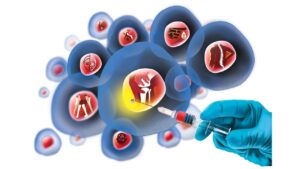Diabetic neuropathy is a debilitating condition affecting a significant portion of the diabetic population. It is characterized by nerve damage caused by prolonged exposure to high blood sugar levels. While prevention through glucose management is crucial, advancements in medical science have provided various treatment options to manage and alleviate diabetic neuropathy symptoms. This article delves into the latest developments in cure for diabetic neuropathy, offering hope and relief to those affected.
Contents
What is Diabetic Neuropathy?

Diabetic neuropathy refers to nerve damage resulting from diabetes mellitus. It can affect any nerve in the body, but most commonly impacts those in the legs and feet. There are several types of diabetic neuropathy, including peripheral neuropathy, autonomic neuropathy, proximal neuropathy, and focal neuropathy. Each type presents with distinct symptoms and requires tailored treatment approaches.
The exact cause of diabetic neuropathy is not fully understood, but prolonged exposure to high blood sugar levels is a significant contributing factor. Other risk factors include uncontrolled diabetes, genetics, smoking, alcohol abuse, and prolonged duration of diabetes.
Symptoms of diabetic neuropathy vary depending on the type and nerves affected. Common symptoms include numbness, tingling, burning sensations, weakness, pain, and loss of reflexes. These symptoms often worsen over time and can lead to serious complications if left untreated.
Diagnosing diabetic neuropathy involves a thorough medical history review, physical examination, and various tests such as nerve conduction studies, electromyography, and blood tests to assess blood sugar levels and rule out other possible causes of neuropathy.
Is There a Cure for Diabetic Neuropathy?
As of now, there is no definitive cure for diabetic neuropathy. Diabetic neuropathy is a complication of diabetes mellitus that results from prolonged exposure to high blood sugar levels, leading to nerve damage. While there is no outright cure, various treatment options aim to manage symptoms and slow the progression of the condition.
Additionally, complementary and alternative therapies such as acupuncture, biofeedback, physical therapy, and transcutaneous electrical nerve stimulation (TENS) offer additional relief for neuropathic symptoms.
While there is no cure, ongoing research is exploring innovative treatment modalities that hold promise for the future. Stem cell therapy, for example, aims to regenerate damaged nerves and restore nerve function by introducing stem cells into affected areas. Early studies show promising results, although further research can validate its efficacy and safety.
Types of Diabetes Neuropathy Cure Methods
Diabetic neuropathy, a complication of diabetes mellitus, encompasses various nerve disorders resulting from prolonged exposure to high blood sugar levels. While there is currently no definitive cure for diabetic neuropathy, several treatment methods aim to alleviate symptoms and improve quality of life. Here are seven types of cure methods:
Medication-Based Treatments

Medication-based treatments are commonly used to manage the symptoms of diabetic neuropathy. Various classes of medications can be prescribed depending on the type and severity of symptoms:
- Pain Relievers: Over-the-counter pain relievers such as acetaminophen and nonsteroidal anti-inflammatory drugs (NSAIDs) can help alleviate mild to moderate neuropathic pain.
- Antidepressants: Certain antidepressant medications, such as tricyclic antidepressants (TCAs) and selective serotonin and norepinephrine reuptake inhibitors (SNRIs), are effective in managing neuropathic pain by altering the perception of pain signals in the brain.
- Anticonvulsants: Drugs commonly used to treat epilepsy, such as gabapentin and pregabalin, have been shown to reduce neuropathic pain by stabilizing abnormal electrical activity in damaged nerves.
- Topical Treatments: Topical medications containing capsaicin or lidocaine can provide localized relief by numbing the affected area or interfering with pain signals.
Lifestyle Modifications

Lifestyle modifications play a crucial role in managing diabetic neuropathy and slowing its progression:
- Blood Sugar Control: Maintaining stable blood sugar levels through proper diet, regular exercise, and medication adherence is essential for preventing further nerve damage and managing symptoms.
- Smoking Cessation: Smoking can exacerbate nerve damage and increase the risk of complications associated with diabetic neuropathy. Quitting smoking can help slow the progression of the condition and improve overall health.
- Alcohol Limitation: Excessive alcohol consumption can worsen neuropathic symptoms and interfere with medication effectiveness. Limiting alcohol intake can help alleviate symptoms and prevent further nerve damage.
- Foot Care: Proper foot care is crucial for preventing complications such as ulcers and infections, which can arise from reduced sensation and circulation in the feet. Regular inspection, moisturizing, and wearing appropriate footwear are essential for maintaining foot health.
Physical Therapy
Physical therapy focuses on improving strength, flexibility, balance, and coordination, which can help alleviate neuropathic symptoms and prevent falls:
- Exercise: Regular exercise, including aerobic activities, strength training, and flexibility exercises, can improve circulation, reduce pain, and enhance overall physical function.
- Balance Training: Balance exercises such as tai chi and yoga can help improve balance and coordination, reducing the risk of falls and injuries.
- Manual Therapy: Techniques such as massage therapy, joint mobilization, and stretching can help alleviate muscle tension, improve range of motion, and reduce pain associated with diabetic neuropathy.
Transcutaneous Electrical Nerve Stimulation (TENS)
Transcutaneous electrical nerve stimulation (TENS) is a non-invasive therapy that involves applying mild electrical currents to the skin through electrodes. TENS is thought to work by stimulating the nerves and blocking pain signals to the brain:
- Pain Relief: TENS can provide immediate pain relief by interfering with the transmission of pain signals along nerve pathways.
- Improvement in Nerve Function: Some studies suggest that TENS may help improve nerve function and promote nerve regeneration over time, although more research is needed to confirm these findings.
- Ease of Use: TENS units are portable and easy to use, allowing individuals to administer therapy at home as needed.
Acupuncture

Acupuncture is an ancient Chinese therapy that involves inserting thin needles into specific points on the body. It is believed to stimulate the body’s natural healing processes and promote overall well-being:
- Pain Reduction: Acupuncture has been shown to effectively reduce neuropathic pain by stimulating the release of endorphins, the body’s natural pain-relieving chemicals.
- Improvement in Nerve Function: Some studies suggest that acupuncture may help improve nerve function and blood circulation, leading to reduced symptoms of diabetic neuropathy.
- Individualized Treatment: Acupuncture treatments are tailored to each individual’s specific symptoms and needs, allowing for personalized care and symptom management.
Nutritional Supplements
Certain nutritional supplements have shown promise in managing diabetic neuropathy symptoms and supporting nerve health:
- Alpha-Lipoic Acid: Alpha-lipoic acid is a powerful antioxidant that can help to reduce neuropathic pain and improve nerve function in some studies.
- Vitamin B12: Vitamin B12 deficiency is common in individuals with diabetes and can exacerbate neuropathic symptoms. Supplementing with vitamin B12 may help alleviate symptoms and support nerve health.
- Omega-3 Fatty Acids: Omega-3 fatty acids have anti-inflammatory properties and may help reduce inflammation and nerve damage associated with diabetic neuropathy.
Alternative Therapies
In addition to acupuncture, several other alternative therapies may provide relief for diabetic neuropathy symptoms:
- Biofeedback: Biofeedback techniques help individuals learn to control bodily functions such as heart rate and muscle tension, which can reduce stress and alleviate neuropathic pain.
- Mind-Body Therapies: Practices such as meditation, mindfulness, and guided imagery can help reduce stress, improve mood, and enhance overall well-being, which may in turn alleviate neuropathic symptoms.
- Herbal Remedies: Some herbal remedies, such as evening primrose oil and St. John’s wort, can reduce neuropathic pain, although more research can help to confirm their effectiveness and safety.
Emerging Cure Methods for Diabetes Neuropathy

While traditional treatments effectively manage symptoms, ongoing research explores innovative approaches that hold promise for curing diabetic neuropathy. Here are several emerging cure methods:
Stem Cell Therapy
Stem cell therapy offers a groundbreaking approach to regenerate damaged nerves and restore nerve function. The Stem cells possess the unique ability to develop into different cell types, making them ideal candidates for repairing damaged tissues.
In diabetic neuropathy, stem cell therapy aims to replace damaged nerve cells and promote nerve regeneration. Early studies show promising results, with improvements in symptoms and nerve function observed in some patients. Further research can help to optimize treatment protocols and confirm long-term safety and efficacy.
Gene Therapy
Gene therapy holds potential in treating diabetic neuropathy by targeting the underlying genetic factors contributing to nerve damage. By introducing therapeutic genes into affected cells, gene therapy aims to correct genetic abnormalities and restore normal nerve function.
Preclinical studies have shown promising results in animal models, with improvements in nerve regeneration and neuropathic symptoms. Clinical trials are underway to evaluate the safety and efficacy of gene therapy in humans, offering hope for a targeted and long-lasting cure for diabetic neuropathy.
Neurostimulation Techniques
Neurostimulation techniques, such as spinal cord stimulation (SCS) and dorsal root ganglion (DRG) stimulation, provide targeted electrical stimulation to nerves to modulate pain signals and improve nerve function. These minimally invasive procedures involve implanting small devices that deliver electrical impulses to specific nerve pathways.
Neurostimulation has shown promise in reducing neuropathic pain and improving sensory function in diabetic neuropathy patients who are unresponsive to conventional treatments. Ongoing research aims to optimize stimulation parameters and identify patient selection criteria to maximize treatment efficacy.
Growth Factor Therapy
Growth factor therapy involves administering specific proteins or molecules that promote nerve growth and repair. By stimulating nerve regeneration, growth factor therapy aims to reverse nerve damage and restore normal nerve function in diabetic neuropathy.
Various growth factors, such as nerve growth factor (NGF) and vascular endothelial growth factor (VEGF), have shown potential in preclinical studies for promoting nerve regeneration and improving neuropathic symptoms. Clinical trials are underway to evaluate the safety and efficacy of growth factor therapy in humans, offering a promising avenue for curing diabetic neuropathy.
Conclusion
Diabetic neuropathy is a challenging condition that significantly impacts the lives of affected individuals. However, advancements in medical science have led to a better understanding of the disease and the development of various treatment options aimed at alleviating symptoms and improving quality of life. From conventional medications to cutting-edge therapies such as stem cell and gene therapy, the future looks promising for those battling diabetic neuropathy.
By incorporating these advancements into clinical practice and promoting further research, we can continue to enhance treatment outcomes and provide hope for a brighter, pain-free future for individuals living with diabetic neuropathy.
Do you want to get rid of diabetes? Join our online diabetes treatment program and reverse Diabetes naturally through lifestyle changes such as a Personalized Diet plan, Exercise, Yoga, dieticians, and health coaches.

